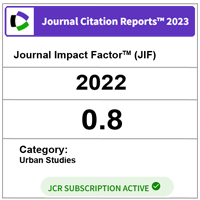A Model for Assessing the Level of Walkability in Urban Neighborhoods in Sri Lanka
DOI:
https://doi.org/10.11113/ijbes.v2.n4.97Abstract
The quality of the neighboring environment plays a major role in encouraging people to walk when attending their daily needs. Although past studies have identified a relationship between neighborhood design factors and the level of walkability, this interdependence is poorly understood in urban planning in Sri Lanka. The purpose of this study is to determine factors and conditions that influence walkability in a selected neighborhood in the town of Panadura and develop a model to predict what design factors enhance walkability in the neighborhood area. Ninety three (93) factors that affect the walkability in urban neighborhood were identified as the findings of the literature review of this study. Seventy six (76) walkability factors identified through perception surveys were examined within a 100m radius of 70 buffered circles representing 140 participants’ residences through a questionnaire survey and field observations. Chi-square and Bivariate correlation analysis were carried out to identify the most decisive factors for walkability. Multiple Linear Regression analysis was applied to develop a model to assess the level of walkability of residents in the selected area based on the most significant factors. The study has identified main nine variables that determine the level of walkability. Based on the significant values the model can be used to assess the level of walkability of the people in Sri Lankan context.
References
Ariffin, R. N. R. & Zahari, R. K., (2013) 'Perceptions of the Urban Walking Environments', Social and Behavioral Sciences, Vol. 105,No. 589 – 597.
Abley, S. (2005) "Walkability Scoping Paper". Retrieved March 04, 2011.
Bahrainy, H., & Khosravi, H. (2013) ‘The impact of urban design features and qualities on walkability and health in under-construction environments: The case of Hashtgerd New Town in Iran’, Cities, Vol. 31, No.17-28.
Besser, L. M. and Dannenberg, A. L. (2005) ‘Walking to public transit steps to Help Meet Physical Activity Recommendations’, Preventive Medicine, Vol. 29, No. 4: 273–280.
Brownson, R. C. et al., (2009) 'Measuring the Built Environment for Physical Activity', Cities, Vol.36, No. 99-123.
Campos, M.B., Chiaraida, A., Smith, A., Stonor, T. & Takamatsu, S. (2003) ‘Towards a 'walkability index' in Proceedings of the European Transport Conference, Online 24th June 2013, http://trid.trb.org/view.aspx?id=771383.
Cerin, E., Saelens, B. E., Sallis, J. F. and Frank, L. D. (2006) ‘Neighborhood Environment Walkability Scale: Validity and Development of a Short Form’, Medicine & Science in Sports & Exercise. Vol. 38, No.9: 1682–1691.
Cervero, R., & Kockelman, K. (1997) ‘Travel demand and the 3Ds: Density, diversity, and design’, Transportation Research D, Vol. 2, No.3: 199–219.
Cervero, R., and Kockelman, K. (1997) ‘Travel demand and the 3ds: Density, Diversity, and Design’,Elsevier Science, Vol. 2, No. 3: 199-219.
Cervero, R., Duncan, M. (2003) ‘Walking, bicycling, and urban landscapes: evidence from San Francisco Bay Area’, Public Health, Vol. 93, No. 9: 1478–1483.
Crane, R., & Crepeau, R. (1998) ‘Does neighborhood design influence travel?A behavioral analysis of travel diary and GIS data’, Transportation Research Part D, Vol.3, No. 4: 225–238.
Doyle, S., Kelly-Schwartz, A., Schlossberg, M., and Stockard, J. (2006) ‘Active community environments and health: the relationship of walkable and safe communities to individual health’, American Planning Association, Vol. 72, No.1: 19-31.
Ewing, R., & Cervero, R. (2010) 'Travel and the Built Environment', Journal of the American Planning Association, Vol. 76, No.1-31.
Forsyth, A., Oakes, J. M., Schmitz, K. H., & Hearst, M. (2007) ‘Does residential density increase walking and other physical activity?’,Urban Studies, Vol. 44, No. 4: 679.
Foster, S., & Giles-Corti, B. (2008) ‘The built environment, neighborhood crime and constrained physical activity: An exploration of inconsistent findings’, Preventive Medicine, Vol. 47, No. 3: 241–251.
Frank, L. and Pivo, G. (1995) ‘The impacts of mixed use and density on the utilization of three modes of travel: the single occupant vehicle, transit, and walking’, Transportation Research Record, No: 1466- 4452.
Frank, L. D., Andresen, M. A., &Schmid, T. L. (2004) ‘Obesity relationships with community design, physical activity, and time spent in cars’, Preventive Medicine, Vol. 27, No. 2: 87–96.
Frank, L., Saelens, B., and Sallis, J. (2003) ‘Environmental correlates of walking and cycling: Findings from the transportation, urban design, and planning literatures’, Annals of Behavioral Medicine, Vol. 25, No.2: 80–91.
Frank, L.D., Sallis, J. F., Conway, T.L., Chapman, J. E., Saelens, B. E. and Bachman, W. (2007) ‘Many Pathways from Land Use to Health: Associations between Neighborhood Walkability and Active Transportation, Body Mass Index, and Air Quality’, American Planning Association, Vol. 72, No.1: 75-87.
Krambeck, H. and Shah, J. (2006) ‘The global walkability index: talk the walk and walk the talk’, No.1-29.
Krizek, K. J., Forsyth, A. and Agrawal, A. W. (2010) Measuring Walking and Cycling Using the PABS (Pedestrian and Bicycling Survey) Approach: A Low-Cost Survey Method for Local Communities, Mineta Transportation Institute, San Jose State University.
Leslie, E., et al. (2005) 'Residents’ perceptions of walkability attributes in objectively different neighborhoods: a pilot study', Health & place, Vol.11, No. 227–236.
Litman, T. (2010) ‘Measuring transportation: traffic, mobility and accessibility’, ITE Journal, Vol.73, No. 10: 28-32.
Lwin, K., & Murayama, Y. (2011) ‘Modeling of urban green space walkability: Eco-friendly walk score calculator’, Computers, Environment and Urban Systems, Vol. 35, No. 5:408-420.
Maleki, M., & Zain, M. (2011) ‘Factors that influence distance to facilities in a sustainable efficient residential site design’, Sustainable Cities and Society, Vol. 1, No. 4: 236-243.
Manaugh, K., & El-Geneidy, A. (2011) ‘Validating walkability indices: how do different households respond to the walkability of their neighborhood? Transportation Research Part D’, Transport and Environment, Vol. 16, No. 4: 309-315.
McNally, K. (2010) ‘Design Guidelines for Walkable Communities’, No. 32: 1-16.
Mitra, R., & Buliung, R. (2014) ‘The influence of neighborhood environment and household travel interactions on school travel behavior: an exploration using geographically-weighted models’, Journal Of Transport Geography, Vol. 36, No. 69-78.
Nankervis M. (1999) ‘The effects of weather and climate on urban bicycle commuters’ decision to ride: A pilot survey’, Road and Transport Research. No. 8: 85–97.
Owen, N, Humpel, N, Leslie, E, Bauman, A, Sallis J.F. (2004) ‘Understanding environmental influences on walking: Review and research agenda’, Preventive Medicine, Vol. 27, No. 67-76.
Özbil, A. and Peponis, J. (2012) ‘The effects of urban form on walking to transit’, Eighth International Space Syntax Symposium, No.1-15.
Parks, J. R., & Schofer, J. L. (2006) ‘Characterizing neighborhood pedestrian environments with secondary data’, Transportation Research Part D, No. 11: 250–263.
Saelens, B. E., & Handy, S. L. (2008) 'Built Environment Correlates of Walking: A Review', Health, Vol. 40, No. 128-200.
Sapawi, R., & Said, I. (2012) 'Constructing Indices Representing Physical Attributes for Walking in Urban Neighborhood Area ', Social and Behavioral Sciences, Vol. 50, No. 179 – 191.
Seneviratne, P. N. & Morral, J. F. (2013) 'Analysis of factors affecting the choice of route of pedestrians', Transportation Planning and Technology, Vol. 10, No. 2: 147-159.
Southworth, M. (2005) ‘Designing the walkable city’, Urban Planning and development, Vol. 131, No.4: 246–257.
Troy, A., and Grove, J. M. (2008) ‘Property values, parks, and crime: A hedonic analysis in Baltimore, MD’, Landscape and Urban Planning, Vol. 87, No. 3: 233–245.
Downloads
Published
How to Cite
Issue
Section
License
Copyright of articles that appear in International Journal of Built Environment and Sustainability belongs exclusively to Penerbit Universiti Teknologi Malaysia (Penerbit UTM Press). This copyright covers the rights to reproduce the article, including reprints, electronic reproductions or any other reproductions of similar nature.
Authors who publish with this journal agree to the following terms:
- This Journal applies Creative Commons Licenses of CC-BY-NC-SA
- Authors retain copyright and grant the journal right of publication with the work simultaneously licensed under a Creative Commons Attribution License that allows others to share the work with an acknowledgement of the work's authorship and publication in this journal.
- Authors are able to enter into separate, additional contractual arrangements for the non-exclusive distribution of the journal's published version of the work (e.g., post it to an institutional repository or publish it in a book), with an acknowledgement of its publication in this journal.
- Authors are permitted and encouraged to post their work online (e.g., in institutional repositories or on their website) prior to and during the submission process, as it can lead to productive exchanges, as well as earlier and greater citation of published work (See The Effect of Open Access).







